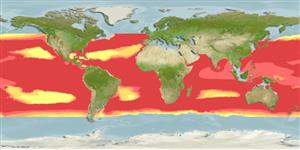>
Lophiiformes (Anglerfishes) >
Melanocetidae (Black Seadevils)
Etymology: Melanocetus: Greek, 'melas' or 'melanos' = black + Greek, 'ketos' = any large sea creature, more often referring to a whale (Ref. 86949); johnsonii: Named for Mr. Johnson of Madeira who found the first individual (Ref. 4525).
More on author: Günther.
Environment: milieu / climate zone / depth range / distribution range
Écologie
marin bathypélagique; profondeur 100 - 4500 m (Ref. 74511), usually 100 - 1500 m (Ref. 4118). Deep-water; 50°N - 50°S, 180°W - 180°E
Tropical to temperate parts of all oceans. South China Sea and East China Sea (Ref.74511).
Taille / Poids / Âge
Maturity: Lm ? range ? - ? cm
Max length : 2.9 cm TL mâle / non sexé; (Ref. 4491); 18.0 cm TL (female)
Description synthétique
Clés d'identification | Morphologie | Morphométrie
Épines dorsales (Total) : 1; Rayons mous dorsaux (Total) : 13 - 17; Épines anales: 0; Rayons mous anaux: 3 - 5. Esca with compressed posterior and anterior crests; anterior margin of vomer nearly straight; minute skin spines present over most of body (Ref. 13608). Branchiostegal rays 6 (Ref. 36493). Caudal-fin rays 8. Scales are cone-shaped, hollow and translucent; with circular base and a free edge pointing towards the caudal region. Left otolith, oblong shape with regular edges, inner face does not present rostrum, antirostrum or cisure (Ref. 41244).
Distinguishing characteristics of metamorphosed female: least outside width between frontals 13.5-28.6% SL; upper jaw with 48-134 teeth, lower jaw 32-78 teeth; length of longest tooth in lower jaw 8.4-25% SL; width of pectoral fin lobe 10.7-17.8% SL; width of escal bulb 4.3-8.6% SL; length of illicium 32.4-60.8% SL; skin with minute spinules over most of body; relatively thick integument 1.55 mm (Ref. 86949). Distinguishing characteristics of metamorphosed male: upper denticular with 9-13 ventrally directed anterior teeth and posteromedial series of 8-11 teeth; lower denticular 12-24 teeth; posterior nostril contiguous with eye; at most 24 olfactory lamellae; skin naked or spinulose (Ref. 86949).
Meso- and bathypelagic (Ref. 58302). Males dwarfed and non-parasitic (Ref. 4491). Caught with plankton nets (Ref. 559). Capable of catching and swallowing prey larger than itself, as witness the approximately 24.0 cm SL specimen of Chauliodus sp. in the stomach of a 6.6 cm SL individual (NMNZ P 14537) (Ref. 58502). Larvae are found primarily in upper 100 m (Ref. 36493). Oviparous, with planktonic larvae (Ref. 36493). Eggs are presumably contained in floating gelatinous rafts (Ref. 36493).
Life cycle and mating behavior
Maturities | Reproduction | Spawnings | Egg(s) | Fecundities | Larves
Anderson, M.E. and R.W. Leslie, 2001. Review of the deep-sea anglerfishes (Lophiiformes: Ceratioidei) of southern Africa. Ichthyological Bulletin of the J.L.B. Smith Institute of Ichthyology 70:30 p. (Ref. 40877)
Statut dans la liste rouge de l'IUCN (Ref. 130435)
Menace pour l'homme
Harmless
Utilisations par l'homme
Pêcheries: sans intérêt
Outils
Articles particuliers
Télécharger en XML
Sources Internet
Estimates based on models
Preferred temperature (Ref.
123201): 3.1 - 19.7, mean 7.4 °C (based on 4346 cells).
Phylogenetic diversity index (Ref.
82804): PD
50 = 0.5312 [Uniqueness, from 0.5 = low to 2.0 = high].
Bayesian length-weight: a=0.01995 (0.00906 - 0.04395), b=3.01 (2.83 - 3.19), in cm total length, based on all LWR estimates for this body shape (Ref.
93245).
Niveau trophique (Ref.
69278): 4.1 ±0.69 se; based on food items.
Fishing Vulnerability (Ref.
59153): Low vulnerability (10 of 100).
